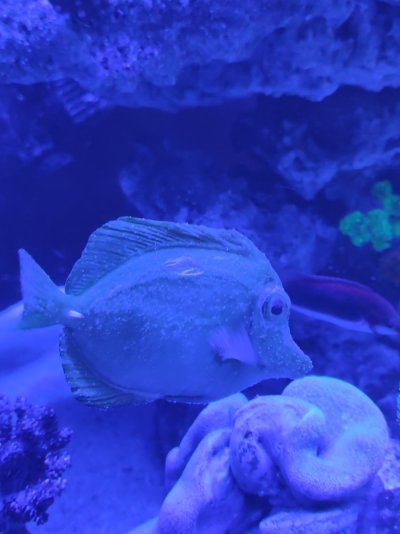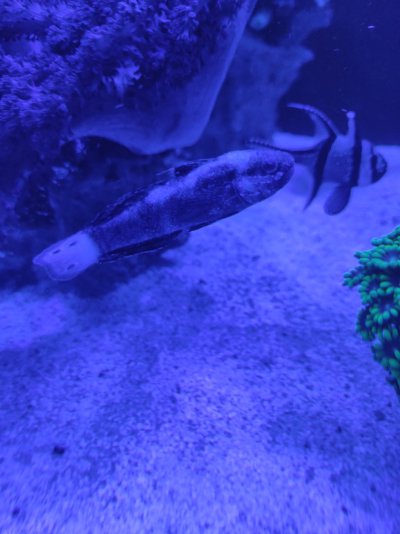many of the examples I've seen for QT have a fresh water dip to kill skin parasites and flukes, does it help and should it be done?2023 Quarantine Procedures
Jay Hemdal
David Scarborough
Protozoans (Cryptocaryon/ich, Amyloodinium/velvet) and Metazoan trematodes/flukes are by far the most common parasites found on newly acquired fish. A carefully managed quarantine process can effectively eliminate these parasites before adding the fish to your display tank. This process does not control Brooklynella, Uronema, viruses or internal parasites. Those issues however, make up a much smaller number of disease cases in marine fish.
Quarantine tank Requirements:
Tank must be large enough to comfortably handle the number and size of fish for up to 9 weeks.
Days 1 – 2: Observation - let the fish settle in and determine proper diet.
- Tank should have a filtration system that has completed the nitrogen cycle. Canisters, HOB overflow filters, or appropriately sized sponge filters are acceptable.
- The filtration system must not use carbon or other absorbing/adsorbing filtrants (e.g. Polyfilter) that might absorb copper or medication. NO calcareous rock LIVE or DEAD
- Bare bottom should be used. A saucer with non-absorbing sand can be utilized for wrasses, gobies, blennies or other species which are overly stressed by the bare bottom. Painting the underside of the tank black can also help
- Heater/thermometer
- Removable structure, e.g. PVC pipe may be used to provide hiding places for the fish.
- Ambient light will often be adequate for the QT tank.
- A means to maintain oxygen levels should be available. Air stones and sponge filters are usually adequate.
- A lid should be used to prevent the fish from jumping out of the tank.
- Set salinity level and temperature to the same levels as in your Display Tank.
Day 2: Begin Copper Treatment
- Set QT temperature to 78 - 80 degrees F.
- Acclimate the new fish to the QT:
- Measure salinity of the water in which the fish arrived.
- Adjust salinity in QT to within 2 ppt of the salinity of the water in which the fish arrived.
- Acclimate the fish to the QT gradually over 45 minutes.
- Observe the fish for any symptoms which might influence the treatment(s) you should administer.
- Determine if the fish are eating adequately to proceed.
Days 3 – 32: Continue Copper Treatment
- Add Coppersafe to the QT to achieve a concentration of 2.25 to 2.50 ppm over the course of 24 hours. This can be done in two doses 12 hours apart or multiple smaller doses if you prefer. Coppersafe will not be effective until a concentration over 2.0 ppm is present. A target of 2.25 ppm will allow for fluctuations without the risk of falling below the 2.0 ppm threshold. Hanna Copper checker is the most accurate test to use.
- Never use ammonia removing products or other reducing agents (dechlorinator) when dosing copper. Most products bind copper with an amine to reduce toxicity to the fish. Reducing agents break that bond, releasing free copper that can harm the fish.
- Feed and top off tank water normally.
Day 34: Copper Done
- Monitor copper ppm regularly. If the copper level remains steady day to day, you can test less often, but if the concentration falls below 2.0 ppm, you may need to restart the 30-day count for the copper treatment.
- Monitor water quality parameters as you would for your display tank.
- If the copper or ammonia levels ever exceed guidelines, be prepared to administer water changes (pre dosed with copper) to correct the problem.
Day 35: Praziquantel Treatment #1
- Begin copper removal through water changes.
- Binding agents Cuprisorb may be used to hasten the removal process.
- Carbon is usually too slow or ineffective at removing copper and should not be relied upon without adequate monitoring.
- Confirm copper has been removed adequately to drop the concentration to less than 1 ppm. Copper and Prazi should not be administered simultaneously.
- Add Prazipro to the QT per the instructions on the label.
- Ensure the additional oxygenation source is working. This treatment will potentially reduce the oxygen levels within the QT to critical levels without additional air flow.
Day 42, Day 49: Praziquantel Treatment #2, #3
- Add Prazipro to the QT per the instructions on the label, 7 days apart. Spacing needed for these treatments is based on killing new flukes hatching from previously laid eggs. The time interval is not well known. A range of 7 to 9 days seems to give the best results.
Day 64: New Fish QT complete
- Observe fish for 2 weeks after last prazi dose. Note: many public aquariums do not move fish out of quarantine unless they are in the middle of a full copper treatment. This vastly reduces the risk from Cryptocaryon or Amyloodinium. To use that method, substitute a copper treatment for this 2 week observation period, and move the fish out around day 10.
- Conduct a 5-minute fresh water dip if the fish is of a species particularly susceptible to Neobenedenia flukes. If flukes are detected, reduce QT salinity to 50% and hold for an additional 35 days.
- Confirm salinity and temperature of QT and DT are the same, add fish to DT.
Variation from this process:
Do not use copper on sharks, rays, eels or flashlight fish.
Wild caught clownfish are prone to Brooklynella, and may need formalin treatments.
All wild caught fish have a potentially high mortality rate from a variety of other reasons, just be aware that losing fish during this quarantine time can happen.
Navigation
Install the app
How to install the app on iOS
Follow along with the video below to see how to install our site as a web app on your home screen.
Note: This feature may not be available in some browsers.
More options
You are using an out of date browser. It may not display this or other websites correctly.
You should upgrade or use an alternative browser.
You should upgrade or use an alternative browser.
Current Quarantine Protocol
- Thread starter Jay Hemdal
- Start date
- Tagged users None
Join the club. I spent yesterday tearing down my tank to catch all fish for QT for ich and possible velvet.ok , so there is probably no other option than take my tank down and catch all fish for quarantine I suppose?
My worst fish was a sleeper goby. After near 30 hours all fish are still alive in QT. pump and heater. 25% WC this morning. Also added Polyplabs medic (can't hurt). All fish got 3 min RODI dip. Anthias looked dead, Chromis seemed like they quiet enjoyed the swim.
Hopefully 3 min killed most of the parasites?
I've been reading up on H2O2 dips. I might try that before the next transfer.
No - FW dips are never 100% effective, and returning the fish to the infected tank negates the benefit even further.many of the examples I've seen for QT have a fresh water dip to kill skin parasites and flukes, does it help and should it be done?
I use FW dips as a diagnostic tool for flukes and sometimes, I’ll dip a fish to kill back the flukes long enough to treat for another disease first, just to buy some time.
Jay
- Joined
- Apr 9, 2020
- Messages
- 997
- Reaction score
- 242
Yes I not think fresh water dips are enough as all fish befor coming in my tanks get one, and also a methylene blue and prazi bath after the quarantine, but still I got this..
- Joined
- Apr 9, 2020
- Messages
- 997
- Reaction score
- 242
On some fish now we can see more maybe someone can helps me to identify what it is, the old zebrasoma is full of white spots whereas the gobie seems to have skin issus and some anthias their tail is same eaten, some have their fins which are no longer very transparent but kind of transparent white. It is not easy to take them in picture and show it. But I got this two
Attachments
My goby looked like that. FW dip certainly helped save him. All my fish look "free" of parasites for now. Unfortunately the goby may lose the worst infected eye. We'll see. But so far my QT with initial FW dip has certainly helped. 3 minutes per fish in RODI water. So far all 15 fish have survivedOn some fish now we can see more maybe someone can helps me to identify what it is, the old zebrasoma is full of white spots whereas the gobie seems to have skin issus and some anthias their tail is same eaten, some have their fins which are no longer very transparent but kind of transparent white. It is not easy to take them in picture and show it. But I got this two
On some fish now we can see more maybe someone can helps me to identify what it is, the old zebrasoma is full of white spots whereas the gobie seems to have skin issus and some anthias their tail is same eaten, some have their fins which are no longer very transparent but kind of transparent white. It is not easy to take them in picture and show it. But I got this two
Now - the blue photos are difficult to see properly (white/natural light is better) but this does not look like flukes, it looks more like what I call "stale ich", that is, an ich infection that has been going on for a long while. Can you post pictures taken under white lights?
Jay
- Joined
- Apr 9, 2020
- Messages
- 997
- Reaction score
- 242
Yes I will try the next days .
Question they are knowed predator to ich or Velvet? When I had my tank full of lie stones I never got such problems in twenty years and never did quarantine before , since I have artificial rocks , i have only problems, could it be that in the life rock they were natural predator that keep them in check
Question they are knowed predator to ich or Velvet? When I had my tank full of lie stones I never got such problems in twenty years and never did quarantine before , since I have artificial rocks , i have only problems, could it be that in the life rock they were natural predator that keep them in check
I asked this same question yesterday. A response was a well established system has all the critters that would or might keep ich/velvet in check. But live rock can also be the source of imported problems.Yes I will try the next days .
Question they are knowed predator to ich or Velvet? When I had my tank full of lie stones I never got such problems in twenty years and never did quarantine before , since I have artificial rocks , i have only problems, could it be that in the life rock they were natural predator that keep them in check
Micro fauna/bacteria may well eat ich in it's different stages?
I’m back for more advice. All fish are thriving in 2.3ppm copper safe - this includes the spotted watchman goby that I thought for sure was doomed. He didn’t eat for 3 days in that poor condition but improved after that, and has been doing great since. No signs of Ich on any fish, but my 2 clowns are showing something with their slime coat. I would say it hasn’t changed better or worse in at least the 3 weeks they’ve been in the treatment tank. Their coat is showing what appears to be small raised mucus spots. Both are eating and behaving quite normal. They also appeared this way for a week or so before moving them into the QT tank.Without a microscope and a skin scrape I can’t say for sure, but this does look like advanced ich not brooklynella.
Jay
Those look like ich still. Did you do a FW dip?
My fish so far look spot free after a few days in QT after a FW dip
My fish so far look spot free after a few days in QT after a FW dip
No freshwater dip but they’ve been in Copper Safe 2.0ppm + for around 3 weeks. Doesn’t seem possible for it to still be ich. To me it’s not the distinguished white specs of Ich as much of the slime coat acting strange.Those look like ich still. Did you do a FW dip?
My fish so far look spot free after a few days in QT after a FW dip
I made it through 18 pages and didn't see these questions asked. Forgive me if I missed it, but is there any particular reason to first treat with copper, then prazi if you're treating proactively with no signs of illness? Not needing to remove copper with more chemicals seems to be a time and money saver (though I assume not a significant amount of either).
Can copper and hyposalinity be run concurrently to control multiple issues that won't be taken care of while only doing doing one or the other? Treat for flukes and ich vs. flukes or ich for example? Or perhaps hypo can help copper be more effective by suppressing some other parasitic infestation?
Can copper and hyposalinity be run concurrently to control multiple issues that won't be taken care of while only doing doing one or the other? Treat for flukes and ich vs. flukes or ich for example? Or perhaps hypo can help copper be more effective by suppressing some other parasitic infestation?
The reason to treat with copper first is that protozoans like Amyloodinium kill much faster that flukes will. It is best to not treat with multiple medications at the same time, so copper first and then prazi for the slower to kill flukes is the best order to treat these.I made it through 18 pages and didn't see these questions asked. Forgive me if I missed it, but is there any particular reason to first treat with copper, then prazi if you're treating proactively with no signs of illness? Not needing to remove copper with more chemicals seems to be a time and money saver (though I assume not a significant amount of either).
Can copper and hyposalinity be run concurrently to control multiple issues that won't be taken care of while only doing doing one or the other? Treat for flukes and ich vs. flukes or ich for example? Or perhaps hypo can help copper be more effective by suppressing some other parasitic infestation?
You can run coppersafe in hyposalinity, but not ionic copper. The same thing applies though - copper and hyposalinity are both somewhat stressful. Alone, they don’t cause acute stress in fish, but combined and you start to see more issues.
Jay
Those look like they could be mucus plugs. Those in turn are a reaction to some stressor - ich can cause that, but not in this case I’d say. I’d continue with the copper for the full 30 days.I’m back for more advice. All fish are thriving in 2.3ppm copper safe - this includes the spotted watchman goby that I thought for sure was doomed. He didn’t eat for 3 days in that poor condition but improved after that, and has been doing great since. No signs of Ich on any fish, but my 2 clowns are showing something with their slime coat. I would say it hasn’t changed better or worse in at least the 3 weeks they’ve been in the treatment tank. Their coat is showing what appears to be small raised mucus spots. Both are eating and behaving quite normal. They also appeared this way for a week or so before moving them into the QT tank.




Jay
Thanks Jay. No chance it’s Brook, right? I would think it would have advanced over the past 3-4 weeks. My plan is to do a big water change (75%) next Saturday and remove the rest with cuprisorb/filter floss. This will be 31 total days above 2.0ppm Copper Safe and 25 days since last sign of any visible Ick on the fish. Does this sound like a decent plan, or should I extend the duration another week?Those look like they could be mucus plugs. Those in turn are a reaction to some stressor - ich can cause that, but not in this case I’d say. I’d continue with the copper for the full 30 days.
Jay
Brook looks more like sheets of mucus. Brook also causes the fish to swim oddly.Thanks Jay. No chance it’s Brook, right? I would think it would have advanced over the past 3-4 weeks. My plan is to do a big water change (75%) next Saturday and remove the rest with cuprisorb/filter floss. This will be 31 total days above 2.0ppm Copper Safe and 25 days since last sign of any visible Ick on the fish. Does this sound like a decent plan, or should I extend the duration another week?
You might consider giving the fish a FW dip to see if these drop off. There is some risk to doing this though.
Otherwise, I don’t think the fish will have a risk of ich after the 30 days time.
Jay
- Joined
- Apr 9, 2020
- Messages
- 997
- Reaction score
- 242
Here I got some better shots two days agoNow - the blue photos are difficult to see properly (white/natural light is better) but this does not look like flukes, it looks more like what I call "stale ich", that is, an ich infection that has been going on for a long while. Can you post pictures taken under white lights?
Jay
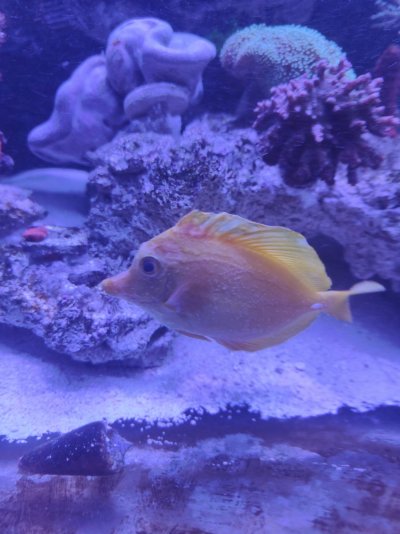
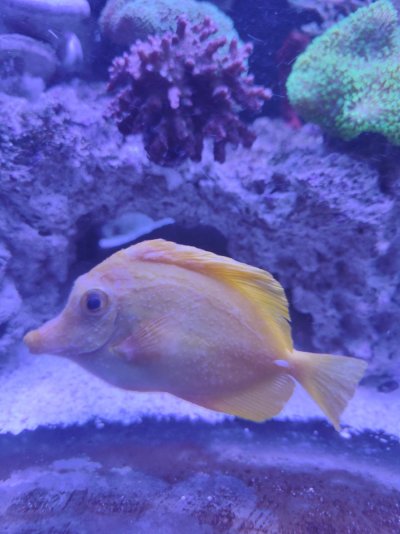
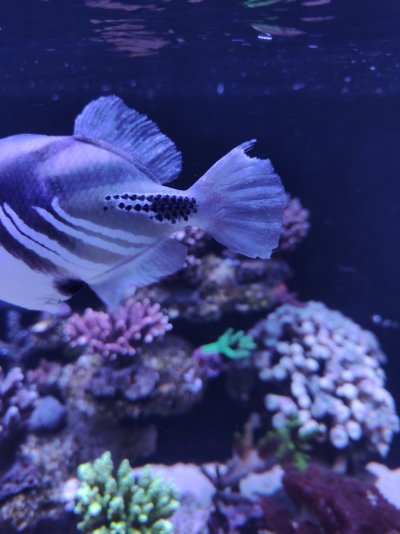
That looks like "stale ich", that is, fish that have had marine ich, Cryptocaryon for a long time.
Jay
- Joined
- Apr 9, 2020
- Messages
- 997
- Reaction score
- 242
what would you recommend then?That looks like "stale ich", that is, fish that have had marine ich, Cryptocaryon for a long time.
Jay
Similar threads
- Replies
- 23
- Views
- 358
- Replies
- 23
- Views
- 341
- Replies
- 11
- Views
- 372
New Posts
-
RO Membrane didn’t help TDS reading high
- Latest: Melissa31595
-
-






